Don't wanna be here? Send us removal request.
Text
Hello Shanel!
Your experience with the dog during your visit to Terceira is beautiful and heart breaking at the same time. I think it shows how genuinely you care for the Earth’s creatures and how naturally it comes to you. While wonderful, having endless empathy can be so tiring. Feeling the weight and responsibility of taking care of the planet is a lot to bear daily, the saying “ignorance is bliss” makes perfect sense.
This is why I think the mindset you describe having before beginning this course is super relatable and feel like many of us have been there. You describe feeling powerless and that being a nature interpreter is a commitment, and I agree with you. The easier choice would be to try and block out the animal’s plight, but instead you were able to delve further into the connection between all living beings. To me, this is one of the major underlying themes in the fight against climate change and the uphill battle that is species protection. It is so much easier to avoid thinking about how we may be harming the planet, and to make these issues someone else’s problem, just like you could have chosen not to be touched by your time in Terceira. Instead, you were inspired, and you have shared your inspiration with us too.
You go on to mention storytelling as a delivery method you use, and I believe your post is proof of your ability! You have interpreted for us through the dog’s story, the importance of caring for the left behind and forgotten.
Thanks for sharing with us your experience and the lessons you took away. I hope you continue to share!
Final Blog
Describe your personal ethic as you develop as a nature interpreter. What beliefs do you bring? What responsibilities do you have? What approaches are most suitable for you as an individual?
To start, I think it's important to tell you my mindset before I started this nature interpretation course. My outlook on the relationship between humans and the environment was clouded in negativity and pessimism. The overwhelming sense of helplessness in the face of environmental degradation had led me to lose hope. A transformative experience during a family trip to Portugal's Azores Islands one summer forced me to confront the harsh realities of the human impact on the environment.
My connection to the Azores was deeply rooted in family ties, as my father had grown up on Terceira, one of the islands. Excitement buzzed within me as I anticipated exploring the rich culture and meeting long-awaited relatives. Little did I know that this journey would reshape not only my perception of the culture but also my understanding of humanity's relationship with the natural world.
The moment that remains etched in my memory is encountering stray dogs on the streets of Terceira. One image, in particular, lingers—a three-legged dog navigating the crowded beach, scavenging for survival. Astonishingly, this seemed to be the norm, accepted by the islanders as part of daily life. The harsh reality hit me when I visited my grandmother's countryside home, only to find her neighbour chaining multiple dogs to their house, surviving on stale portions of bread. The dogs were denied the most basic elements of a dog's life—walks, human connection, and exposure to the outdoors.
As a dog lover, I couldn't turn a blind eye. I freed one of the dogs, and for the rest of the trip she came everywhere with me. Many moments with the dog and I were the first she ever experienced how to be a dog. However, the painful dilemma arose when I had to return her to the chained-up wall before leaving. Did I truly make a difference, or did I unknowingly subject her to more heartache?
This experience, though emotionally charged, was a cultural shock that revealed the absence of animal welfare laws and services on Terceira. The lack of legal safeguards against animal cruelty and the absence of an animal control system spoke volumes about the necessity of shelters and services in maintaining a humane society.
In that moment, I felt powerless—confronted with the harsh reality that there seemed to be nothing I could do to address the systemic issues contributing to the mistreatment of animals on the island. The trip left me questioning the effects of my actions and the impact of individual efforts in the face of a deeply rooted problem.
However, enrolling in a nature interpretation course became the catalyst for a shift in perspective. It rekindled a sense of hope by revealing the ways I could leverage my abilities to share the profound impacts of human behaviour on the environment. The journey of becoming a nature interpreter is not just a choice; it's a passionate commitment to fostering a deeper connection between people and the natural world. As I navigate the enriching course of nature interpretation, my personal ethic evolves, contributing to my beliefs, responsibilities, and approaches that shape the lens through which I perceive and communicate the wonders of nature.
Foundations of belief:
The story of my trip in Terceira forms the foundation of my belief in the interconnectedness of all living beings. It underscored the intricate relationship between human actions and the well-being of animals, emphasizing the need for compassion and responsibility. The dogs surviving on the streets of Terceira weren't just part of the landscape; they were sentient beings with their own worth. Nature, I realized, is not separate from us; it is an integral part of our existence, deserving of respect and protection.
I also believe in the transformative power of nature experiences. Nature has a unique ability to inspire awe, curiosity, and a sense of belonging. As a nature interpreter, I carry the belief that by fostering a meaningful connection with the environment, we create caretakers of the Earth – individuals motivated to protect and preserve the precious ecosystems.
Responsibilities as a nature interpreter:
One primary responsibility is to bridge the gap between the scientific intricacies of nature and the diverse audience I engage with. It's not just about presenting facts but about crafting narratives that resonate with people from all walks of life. This requires careful consideration of cultural contexts, diverse perspectives, and the emotional connection individuals have with nature.
Equally important is the responsibility to instill a sense of wonder and curiosity. Nature interpretation isn't solely about imparting knowledge; it's about sparking a genuine interest and fostering a lifelong love for the natural world. Cultivating curiosity encourages continuous learning and a desire to explore the mysteries of nature. It's about empowering individuals to take positive actions, whether big or small, to contribute to the well-being of the planet.
Approaches aligned with my individuality:
As I navigate nature interpretation, I've come to realize that my individual personality and insights play a crucial role in how I connect with others. One of my key approaches is the cultivation of curiosity. I believe in igniting the spark of wonder that resides within each person. By fostering curiosity, I aim to inspire a lifelong love for learning about the natural world.
Storytelling is another powerful tool in my interpretive arsenal. By weaving narratives that highlight the intricate relationships within ecosystems or the struggles of individual species, I aim to captivate hearts and minds. Stories have the ability to evoke empathy and forge lasting connections between people and the environment.
My approach is rooted in the idea that experiences in nature are transformative. Whether it's a serene walk in the woods, the exhilaration of spotting a rare bird, or the beauty of a breathtaking sunset, these experiences have the power to evoke emotions and create lasting memories. I believe in fostering these personal connections with nature, as they often serve as the catalyst for a deeper understanding and commitment to conservation.
Furthermore, I recognize the importance of fostering a sense of community. Nature interpretation is not a solo endeavour but a collective journey. By building a community of individuals passionate about nature, we amplify our impact and create a network of like-minded individuals dedicated to the preservation of our planet.
What the course taught me:
Through this course, I found my passion for nature reignited. It became clear that my role as a nature interpreter is about using my voice and creative expressions to weave narratives that resonate with others. By fostering an understanding of the interconnectedness between humans and the environment, I believe we can inspire collective action and pave the way for positive change.
Through the readings, discussions, and interacting with other students blogs, I've gained valuable insights into different perspectives of nature interpretation. The course has reinforced the idea that effective interpretation is not a "one size fits all" approach, but requires adaptability and creativity.
In conclusion, as I evolve as a nature interpreter, my ethic is influenced by my interconnectedness, responsibility, wonder, and inclusivity. Guided by these principles, I embark on a mission to inspire others to appreciate, understand, and protect the extraordinary beauty of the natural world. 🌿🌎✨
Thanks for reading :)
Shanel
4 notes
·
View notes
Text
Hi Skyler!
I find your final post easy to follow and understand, especially with your many references to our course content!
I relate to your sentiment about demanding more environmentally conscience practices from governments and corporations, something I also expressed frustration with, in my own post. I think you are right about systemic change being crucial. In my own post, I focused mostly on individual actions, but I think we are making the same point from two different sides (both of which are necessary). Our arguments go hand in hand, because environmentally conscious lifestyle changes are not accessible to the average citizen without systemic support. One example that comes to mind is the terrible urban planning mentioned in the David Suzuki and Richard Louv video. If you live outside of the GTA, you probably don’t live in a walkable, bikeable city, or have accessible public transport. Some regions of the GTA are not ideal either, I live in Caledon and public transportation is pretty much non-existent here. We need better urban planning, and public transportation, in order to trade out cars for these options.
I appreciate your example about the Inuit community in Baffinland. I feel that there is increasing need for stories like these, that can instill hope and show us examples of togetherness. The brave mine workers who went against their employer and stood with the affected community, that is touching and a lovely example of the humanity we need now and for the future. Our society has become extremely individualistic and there is this idea that we don’t owe each other anything, but I disagree! We owe each other a sustainable today for an equitable tomorrow!
Hope the end of your semester goes smoothly 😊
Blog Post 9 - Final Prompt
Throughout the semester, we have repeatedly been posed the same three questions: “Who am I as a nature interpreter?”, “Who is my audience?”, and “How can I make this experience meaningful?” In considering my answer to these questions, I’ve been forced to examine my own beliefs, the responsibilities I have to my audience, and the approaches that will best help me to accomplish my goals as an interpreter.
The question “Who am I as a nature interpreter?” can only be answered by first answering “why do I want to be a nature interpreter?”. For me the answer to this question is simple: I want to change the world. I believe that to truly be able to reverse the effects of climate change and pollution, we need major systemic change. For decades environmental scientists have been telling world leaders and major corporations that they are destroying the planet, but their calls for action have fallen mostly on deaf ears. Even before I began studying conservation, I have always felt a strong sense of anger at this injustice. I feel obligated to protect nature because, like all of you, I am a part of the natural world. When people begin to recognize how connected we all are, and the consequences that the majority of us now face for the actions of a privileged few, it only makes sense to unite and fight back. A prime example of this kind of solidarity came in the form of a letter sent by a group of miners to the activists blockading the iron mine where they worked. The local inuit community in Baffinland had expressed their concerns over the effect the expansion of the mine would have on wildlife, and how the loss of wildlife would in turn affect their livelihood - their ability to hunt. When their concerns continued to go unaddressed, a group of local hunters - the Nuluujaaq Land Guardians - decided to take the defense of their local ecosystem into their own hands. Despite the fact that this blockade meant many workers were stranded in Nunavut, a number of the mine workers decided to express their support for the blockade rather than siding with their bosses who had pushed through the expansion project. Their letter was inspiring, and I encourage you all to take a moment to read it in full. One quote in particular stood out to me, and summarizes the exact sentiment I hope to inspire as a nature interpreter: “This country has seen the consequences of entitlement and greed that have led to the destruction of the land for profit, and we are glad you are fighting for autonomy over your land.” When I see this kind of solidarity I am left wondering: what can I do as an interpreter to foster this sense of responsibility for each other and the natural landscapes we share?
If my goal is to spark a connection with nature strong enough that it inspires my audience to fight for real systemic change, I need to carefully consider who my audience is and what responsibilities I have to them. To be an effective interpreter means to be able to meet your audience where they’re at. Not everyone has the same amount of background knowledge about the natural world, and not everyone learns in the same way. With small-group, in-person nature programming, it’s easier to adapt the way you present your information for people with different learning styles. When your goal is to reach people on a broader scale, as I aim to do, accounting for different needs becomes more complicated. This does not mean that accessibility can simply be ignored, in fact it only makes it all the more necessary. Different people face different barriers when it comes to accessing nature programming, many of which (ability to get to provincial parks, time to attend workshops, etc.) can be addressed with the mindful use of technology. Social media gives interpreters a larger platform to connect people with nature than ever before, and it allows people to learn about nature without having to leave their homes. However, this brings to mind the question posed to us in unit 5: “How do you engage [your audience] when you are creating content (whether blogging or podcasting) and then really leaving it out there for them to interpret themselves)?” How can I use my platform on the internet to spark lasting relationships with nature, when everyone who comes across my content may have different learning styles, needs and/or interests? Overcoming this challenge will require the development of a wide range of skills, the humility to recognize what isn’t working, and a willingness to change my approach to engage as many people as possible.
Creating engaging programming is the bread and butter of our job as nature interpreters. By producing content that is both interesting and easily accessible, I can foster meaningful and lasting relationships between my audience & the environment which will hopefully inspire the kind of dedicated environmental activism we so dearly need. There are a number of different approaches that interpreters can take to create meaning for their audience. One such approach is the integration of art into nature programming. Art can open people up to consider different perspectives. Art can also be an effective vehicle to communicate the ‘gift of beauty’ that nature provides, sparking wonder and curiosity about one’s own local environment. To inspire action requires one to foster these connections with nature, but it also means making people aware of the threats that our ecosystems face. It's about finding a delicate balance between listing off facts, and creating memorable experiences. While it's important to consider what exactly will be the most effective way to engage your audience, with their myriad different interests and backgrounds, unit 3 of this course gave some advice that is equally important to consider: “Sometimes an audience won’t be receptive. Sometimes it won’t work. And it takes some courage to humbly acknowledge that despite your best efforts, you won’t always be able to win everyone over.”
Though I may not be able to reach everyone with my approach, that isn’t my ultimate goal - my goal as a nature interpreter is to spark a deep and lasting connection to nature in as many people as I possibly can. When you’re going up against powerful companies that continue to put profit above our local ecosystems, our lives, and our planet, you need as much ‘strength in numbers' as you can get. With the knowledge I have gained this semester I feel equipped to begin my journey as a nature interpreter, with the hopes of securing a brighter future for us all - and for the ecosystems we call home.
4 notes
·
View notes
Text
Small actions, big outcomes! Environment as a frequent classroom topic!
Describe your personal ethic as you develop as a nature interpreter. What beliefs do you bring? What responsibilities do you have? What approaches are most suitable for you as an individual?
This is my final blog post and you likely do not know who I am, but if you are interested, I invite you to delve into Madeline Fantin’s interpretive ethics, values, and ideas for the future.
To start, what beliefs do I bring? I am a wildlife biology and conservation student; therefore, the vast majority of my courses have looked through a scientific lens (western science that is). Perhaps the reason I chose my program is due to possibly my most core belief, that individuals have the power and influence necessary to make a real difference. This is why I became a vegetarian even though my entirely Italian family thinks I’m bonkers, I think one person cutting their carbon emissions is a worthwhile effort. Are billionaires flying their private jets around for unsatisfactory reasons and investing in all kinds of large corporations who dump pollution directly into our environment? Yes of course, and don’t get me wrong, I think part of the fight towards a healthy planet is holding the extremely wealthy accountable. Perhaps they are hoping we will put all the blame on ourselves so that we ignore their insurmountable consumption. However, we are consumers too and where possible, we can choose where to put our money and how to live our lives to a certain extent. I believe that however small, the average citizen’s fight against climate change is valuable and necessary. In conversations I have had with the people in my life, I have learned that many people become unmotivated by the “all or nothing” mindset. For example, I frequently hear people say that they “could never go without meat all the time.” So don’t! Have meatless Mondays! Have meatless weekends! Go pescatarian! Go meatless biweekly! There are unlimited combinations of schedules that could provide a more reasonable expectation. The effort doesn’t need to be “perfect” to be worth something. This can be applied to many environmental actions. In most places in Ontario, it wouldn’t be reasonable to ask people to use public transport or bike as a main form of transportation. Most cities don’t have great public transport, and most people live a long, long bike ride away from their place of work. However just because you cannot bike to work doesn’t mean you can’t ever trade the car for your bike. Maybe there’s a friend you often visit just on the other side of the neighborhood, and maybe you usually drive to them, but when the weather is ideal and if you are able, the bike could work! Many “imperfect” actions are better than no action at all I promise!!!! There is no shame in not being the perfect environmentalist all the time, it is near impossible in the society we have created.
I also believe that there is something to be gained from spending time in nature, for anyone. Whether that is a chance to gather thoughts, get some exercise, some vitamin D, you name it. I don’t think it needs to be picturesque either. Sometimes connecting with nature looks like sitting on the curb outside your east campus townhouse because the sun has reappeared after some days of gloom. Sometimes you will have the energy to head to the arboretum, but when you don’t, taking a sunny break on the curb is better than skipping the outdoors all together. Again, it doesn’t have to be all or nothing.
I believe it is never too late to get started! Everyone, no matter the age or circumstance, should feel like they have a place in the world of nature interpretation and the outdoors. Having not grown up in an outdoor adventure family doesn’t mean you can’t have any outdoor adventures! On that point, outdoor adventures are whatever you make them. They need not be a costly trip to the other side of the continent. Someone with the right mindset could gain more from an hour by the local creek, than someone with the wrong mindset on their trip to Mount Kilimanjaro.
What responsibilities do I have? Well, there are the obvious ones such as to deliver the program I have advertised, inform guests about risk, manage and prevent dangers, present accurate information, check my bias and privilege, to be fun and engaging, and for guests to leave feeling like they have benefitted in some way. Other more specific responsibilities I believe depend on the approach…
So what approaches are the most suitable for me? Well, it is my goal to get into teaching in high school classrooms. This is not the type of environment we have spent the last few months discussing, but nonetheless I think there is a ton of relevant overlap. Nature interpretation could take place in the classroom, or the school yard. There may also be opportunity for class trips where students could be exposed to new ways of learning or new environments.
When relevant to the content, I would aim to stimulate interest and conversation about the environment and environmental issues happening around the world, as they relate to us in Canada and otherwise. I probably plan on living in Canada, and therefore will need to create programs suitable for all 4 seasons. This could mean the same topic modified with each passing season, different topics in each season, or a combination. I am excited to take advantage of the variance each season brings. I think many topics in the high school curriculum could benefit from an environmental lense, and I would look to make connections throughout where possible.
I would look to encourage active learning and participation through mediums the students may be interested in, just like we talked about all the different mediums of nature interpretation. If I’m teaching grade 9 or 10 science, then this class is still required of them, and many may only be there by necessity. They might not want to be there or have particular interest in the content, which is ok, and I would need to navigate how to still make sure they get what they are meant to, even if they never develop excitement about it.
To revisit responsibilities, as a teacher I must provide a classroom environment conducive to learning, where everyone feels comfortable, valued, and that students look forward to attending each day.
For my final blog post outro (☹), I will say that climate doomism is very contagious and easy to get wrapped up in. I think one of the most important things we can do as nature interpreters is spark hope for change. You never know who is looking to you when they are feeling discouraged about the state of the world, and how you can provide them motivation to keep fighting the good fight!
11 notes
·
View notes
Text
Hi Leena!
Your take on this question is super unique and cool to read! The pyramids of Giza are one of my favourite pieces of history to talk about. Visiting them is one of my bucket list items for sure! Every now and then I go down a rabbit hole of obscure coincidences and details regarding the pyramids, I just find them endlessly fascinating!
Your trip to the Griffith Observatory sounds spectacular and I think you bring up an important piece of the interpretation puzzle. Many natural phenomenon can be difficult for us to picture and wrap our heads around, for example I probably underestimate the size of the Great Pyramid simply because it is so massive and I haven't had the opportunity to get a good reference of scale.
I think a lot of concepts relating to space make good brain teasers too, and that is why programs like the Signs of Life show that you went to are so valuable. The sheer size or distance of cosmic objects is barely computable (at least for my brain), and what about the concept of time dilation(?!?!?!?)? I feel that if we have trouble understanding something or don't have opportunities to, we might simply ignore it and never truly get a sense of the wonder that is all around us.
There are so many fascinating features of our planet and elsewhere in the universe, that have been made easier to grasp by various forms of interpretation. Without which, we may forget how wild, amazing, and impossible this existence is!
Thanks for the reminder!
Unit 9 Blog Post
Interpet (through this blog) the most amazing thing you know about nature – get us excited. This is your blog – your audience isn’t in the field with you so bring the field to your armchair reader.
There are so many concepts of nature that I can speak upon that amaze me, such as bioluminesence, the beauty of the northern lights, and the captivating diversity in nature. However, for this week’s blog, I wanted to take a different approach and reflect upon the beauty that humans have provided within nature. Every piece tells a fascinating story; a collection can form a narrative that spans centuries, continents, and cultures.
I find it astounding to look back at the technical wonders that have shaped history, especially as we stand on the shoulders of innovation in the 21st century. When the world's wonders, like the Great Wall of China, the Pyramids of Giza, and the Colosseum, were built, they were engineering marvels. Fast forward to the present, and we are surrounded by a brand new category of wonder: the digital world.
I believe that a lot of the reason we are able to look back and appreciate our history is due to technology. It makes it so convenient for all of us to enhance our knowledge on a topic or concept that we find interesting. It is also worth noting that technology can aid in the transmission of interpretive messages at sites, allowing more visitors to learn about the location (Beck et al. 2018, p. 465). For example, when my family and I went to Los Angeles, we visited the Griffith Observatory (same planetarium seen in ‘La La Land’!). During this visit, we watched a show at the Dome at the planetarium that used the Zeiss Star Projector. The live show we watched was ‘Signs of Life’ which uncovered what it took to put life in the universe. I was truly captivated, along with the audience, by the magnificence of technology and how it can be used to interpret aspects of our history.
In the modern era, prominent technological wonders include the Hubble Space Telescope, the International Space Station, and Mars rovers. These innovative technologies have allowed for explanations of many mysteries in space as well as discoveries. Furthermore, the Hubble Space Telescope has provided us with countless stunning photos of space exploration and the beauty that exists within our solar system—a universe that will never cease to amaze me.
However, among these technological wonders, it is important not to forget the wonders that breathe history—true testaments to human ingenuity and ambition. Each structure within nature holds a unique place in history, leaving a persistent mark on the world (Beck et al. 2018, p. 329). As an Egyptian, it only feels fitting for me to speak of the brilliance of the pyramids of Giza. This is the only one of the Ancient Wonders of the World to survive largely intact today, along with its intricate details and massive scale. Though it remains a mystery how the ancient Egyptians built the pyramids without modern technology, it sparks many theories on how exactly they were created. Nevertheless, it’s inspiring how these architectural marvels, whether ancient or modern, captivate tourists with their awe-inspiring designs and historical significance.
I hope you all find this as interesting as I do, we're embedded within nature and that includes the history that precedes us and continues to evolve. It is also fascinating to me personally how technology and the human creations embedded within nature can strive for many diverse interpretations!
I have provided some images taken from the Hubble Space telescope below :)


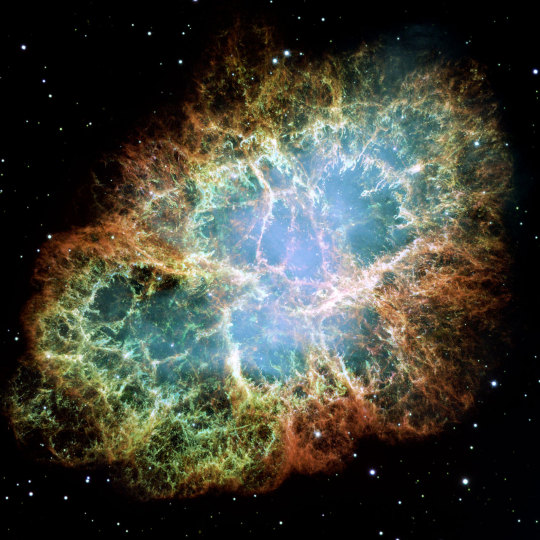
References
Beck, L., Cable, T.T., & Knudson, D.M. (2018). Interpreting Cultural and Natural Heritage For a Better World. Sagamore-Venture Publishing.
2 notes
·
View notes
Text
Bustling Bugs and Productivity Praising
(continued)
I think knowing that there are teeny tiny insects who have mastered a skill considered to be a “human” skill, such as agriculture, causes people to reflect.
Clearly, other species are capable of using practices that we use. What makes humans so dominant? What makes us think and act as though we are above all other species? Multiple animals much smaller than us figured out the agricultural system way before we did, and that has to count for something. Do we measure worthiness through productivity? This is a flaw in our own society, we often do measure people’s worthiness by their contributions and ability to work. We sometimes speak a certain way (denoting lesser worth or importance) about certain demographics such as people who don’t choose to work a 9-5, the elderly, people who are unable to have a steady/traditional job etc. Shouldn’t being human mean being worthy? So what about other life forms? I think sometimes in order for people to care about something, it has to be humanized in some way. In western society, we have a self-centered approach to existing on the Earth. In my opinion, I think our need to recognize something as “human” before we deem it worthy is a flaw of ours. Ants and beetles are not as charismatic as let’s say bears or deer. If this information about insect agriculture is new to you, do you find yourself caring more about them now that you know of these abilities they have? Maybe that is a stretch, but I think the underlying theme is important. We are quick to judge species’ relevance by seeing how they measure up to us humans, when I think we should be seeing species in their own light.
You might be thinking, okay I was reading some interesting stuff about bugs and then it turned into a lesson on human ethics and now I’m not really following. That would be understandable because when you hear “insect agriculture” your mind probably doesn’t jump to “the elderly/the unemployed/the disabled/the sick/etc/etc/etc should be seen as worthy as the CEO”.
I think it is important to find lessons within nature where we can. I was very much in awe when I first learned about insect agriculture, and I thought my reaction could say something about the way we treat not only animals and plants, but eachother as people. Sometimes the way we reflect on nature can tell us what kind of things we need to be changing in our society. To me, the way I felt more connected to these agricultural insect species reminded me of how we need to move away from using productivity to measure people’s value.
I hope it makes sense, let me know your thoughts!
0 notes
Text
The OG Agronomists
Interpret (through this blog) the most amazing thing you know about nature – get us excited. This is your blog – you audience isn’t out in the field with you so bring the field to your armchair reader.
Most people that know me, know that I am a bug person. Sometimes, they ask me what the coolest thing about bugs is. I think there’s loads, however I usually always respond with the same answer. Insect agriculture! I first learned about this in-depth last winter semester, when I took ENVS 3090, Insect Diversity & Biology. Therefore, my source is Dr. Andrew Young, but I will cite and link some literature, so you don’t just have to take my word for it!
Insects have been doing agriculture way longer than we have! We think insect agriculture started somewhere between 50-90 million years ago. The origins of farming insects (phys.org)
Humans only started using this practice somewhere around 12 000 years ago. The Development of Agriculture (nationalgeographic.org). Granted, insects have been around way way longer than we have, but I still think this is a crazy feat.
Let’s start with leaf cutter ants. There are around 40 species, and they are characterized by their behavior of chopping up and carrying leaves. Their job of cutting the leaves is made easier by their specialized mandibles, which are like tiny insect power tools. Their jaws vibrate and are super strong, the equivalent of a person carrying a car between their teeth. Just absolutely wild!!!!!
It would make sense to assume that they eat these leaves, but they actually do not use the leaves themselves as a food source! They consume the sap, before carrying the leaves back to their colony. There, they crush the leaves, put them in piles, and inoculate the piles with fungal spores. The ants secrete a substance that protects the fungus from harmful microbes, insuring them a well-nurtured crop. This fungus grows and is fed to the immatures of the colony. To me, the craziest thing about this is that the fungus type is colony-specific and is not found anywhere else. They also have varying caste sizes and “jobs”, for example there are larger ants that clear the forage paths and carry the leaves, while smaller castes will hang out on the leaves being carried, to defend them from parasitoid wasps that want to lay eggs on the leaves. Super cool that they all have a skill that they were made to do!
9 Facts About Leafcutter Ants (treehugger.com)
Then there’s the Termitidae that grows the Termitomyces fungi. The termites forage around for plant material to bring back to the colony, and as they do this, they pick up fungus from the environment. This fungus will also find its way into their specialized gut, where it gets pooped out onto the plant matter they have brought to the colony. The fungus then grows inside the colony and is used as a food source for all castes and life stages. Multiple species of fungus often end up growing, and sometimes the termites will even select for the most productive and successful type. Even termites have a favourite dish on the menu! Termitomyces fungus combs—formation, structure, and functional aspects - ScienceDirect
The last one I will talk about is the ambrosia beetle, known for cultivating the ambrosia fungus. They use their mandibles to carve out galleries in bark, where they will end up planting their fungus spores. The spores are carried by the females in a built-in pouch they have on their bodies. The fungus is used to feed immatures, as well as the adults. The larvae are put in the galleries so that as they grow, they can feed. Before leaving their maternal gallery, they will fill their own pouches with the fungus so that they can grow their own source in a new gallery. Like the leaf cutter ant’s fungus, the ambrosia fungus is not found any place other than ambrosia beetle galleries! Our use of the word “galleries” makes me imagine these carved-out pockets as canvases that the beetles use to decorate with the fungus. Ambrosia beetles breed and maintain their own food fungi (phys.org)
I remember in one of our textbook readings, there was a chapter that explained how mentioning the fact that something is amazing or spectacular can sometimes take away from the information/presentation/view etc. So, I will not do that here.
I just picture these species being so content with their food choice that they’ve decided they’re going to have the same breakfast, lunch and dinner forever and ever and honestly, I relate because that is how I feel about pasta.
Animals big or small, we’re all just out here trying to feed ourselves and our families as efficiently as possible. Maybe we aren’t as different as it may seem. (continued in a second post)
0 notes
Text
Hey Keith!
I like your point you made about artists pulling aspects from their hometown or a place that is meaningful to them into their art. It further supports the concept behind our course, that nature interpretation can and should take many forms. I think your reference to the melancholy feeling of Folklore is a great example of this less obvious kind of nature interpretation, and I want to attempt to expand on it. This kind of nature interpretation isn't super in your face regarding facts and scientific processes, but I would argue it is just as effective at doing the job of invoking emotions and has the potential to spark an interpretive journey.
Your Folklore example of the trees reminded me of the song Stick Season by Noah Kahan. "And I love Vermont, but it's the season of the sticks", being one of his most famous verses. At first, I was super confused by "season of the sticks". However, I think he is referring to the trees being bare at the end of the autumn season. It isn't yet winter, all pretty, white and cozy, but the in between, after the colourful days of fall have passed. He is saying Vermont is a super scenic place to be, but still has an "off season", or a period of mourning what is gone and awaiting what is to come. At least, this is how I interpreted it. I think this reminds us that even nature takes a break sometimes, and most parts of nature cannot be productive all year round. Taking a break or being in a "waiting season" of life is okay and even to be expected.
I think songs like these remind us that to be human is to be nature and if we forget that, it can have consequences.
Music and Nature
Where is music in nature? Where is nature in music?
As a follow-up (focus on the above two before you tackle this one), what song takes you immediately back to a natural landscape? What is the context? Share it with us – I would imagine many of these ideas may have similar underpinnings of a campfire, roadtrip, backpacking journey, etc.!
Music and nature are two things that at first thought, seem to be distinct from one another, however, throughout the history of this world, that could not be farther from the truth. Music can be seen and heard throughout nature, and nature can be seen and heard in music.
Where is Music in Nature?
When the statement that music is in nature is stated, the natural question to ask is “where”, and the response is not straightforward. Music is everywhere in nature, it is in the birdsongs heard early in the morning, it is heard in the wind through the trees, it is heard in the crickets at night, and everywhere in-between. The music is all around, ever-present, and provides not only a reminder, but an inspiration to all kinds of artists and people about our interconnectedness with nature.
Where is Nature in Music?
On the opposite side, music is often evocative of nature, whether it be through the direct lyrics, the melodies and rhythms, or even the emotions of the music. Many songs draw inspiration directly from nature and many artists use nature as their muse, whether it be hometown landscapes or the comparison of a forest to the big city in their music, or through their album covers, showing the different emotions one can have in nature, such as the cover of Taylor Swift’s ‘Folklore’. Taylors comparison to the large, abundant trees in the forest of the album cover further insist upon the melancholic experiences on the album, and one can imagine the sounds that would be heard within the isolation and the forest that she is in on the cover.
Songs That Transport to Natural Landscapes
Music to the vast majority of people has the power to transport. Whether this transport be to the past, the memories they have when they first heard the song, or to nature, and an experience in nature that was had to the song. A song that takes me to a natural landscape would have to be “Feels Like Summer” by Childish Gambino. On the surface it can transport you to a summery beachside landscape with its sultry vocals and its melodic beat. However, upon further investigation behind the meaning of the song it also provides a grim reminder of climate change and the effects on the environment.
1 note
·
View note
Text
Hiking with Taylor Swift!
As a follow-up (focus on the above two before you tackle this one), what song takes you immediately back to a natural landscape? What is the context? Share it with us – I would imagine many of these ideas may have similar underpinnings of a campfire, roadtrip, backpacking journey, etc.!
This is such a fun question, and I am happy to share a few answers.
First, the classic Build Me Up Buttercup by The Foundations always takes me back to a summer camp I went to for over a decade. We spent many hot days at the waterfront, and this song was always in the queue (for literally like 11 years), or playing at the mess hall after meal times. The song itself has nothing to do with the outdoors, but I associate it with bright mornings and hot afternoons at camp.
Here is what I picture when I hear this song:
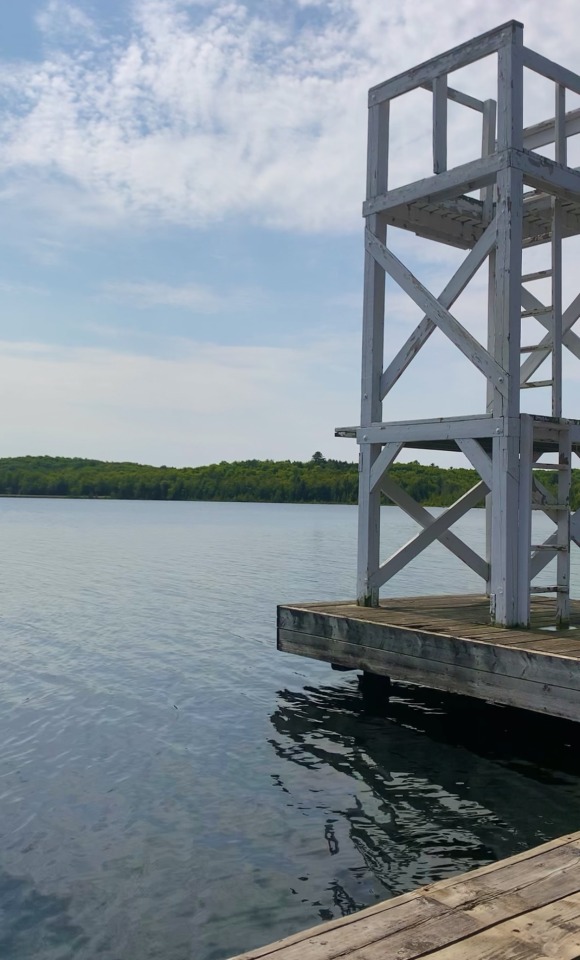
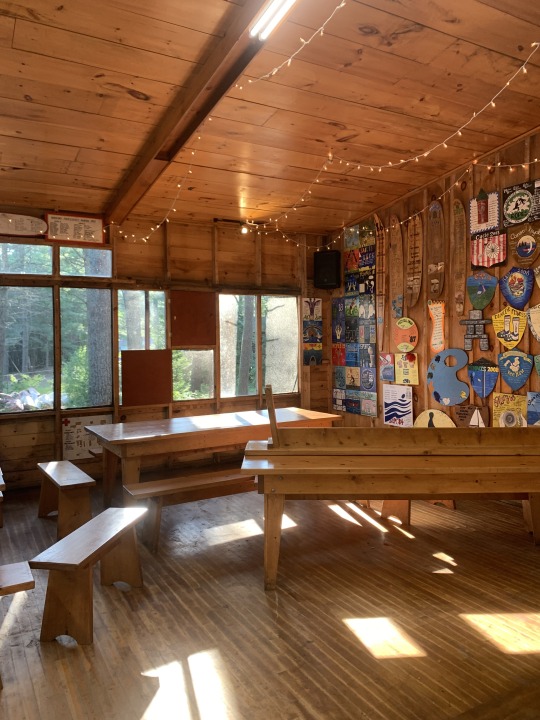
There are a few songs that take me back to my work trip from this past summer. Namely, American Teen by Khalid, Hawaiian Roller Coaster Ride by Mark Keali'i Ho'omalu, and pretty much anything by Taylor Swift. The first one probably seems less intuitive than the second, but the first song was the backbone of our trip. Before our trip, the staff chose a “morning song” that we would play first thing every morning as soon as we got onto the bus. Our trip would be to 4 different US states, and the campers were American, so naturally we chose this song. The lyrics aren’t about nature or the environment, but our trip consisted mostly of national parks, hikes, surfing, and other outdoor activities. We would sing along every morning on our way to our next adventure, and now this song takes me back to driving through the Turnagain Arm in Alaska, or heading to the sand dunes in Oregon.
The second song from this trip is well known thanks to Lilo & Stitch and was a staple for the Hawaii leg of our trip for obvious reasons. When I would listen to that song before my trip, I had a faint picture in my mind of what Hawaii might be like. Now that I have been, I can now associate that song with the experiences I had and the views I saw with my own eyes. This song is very special to me.
Lastly, Taylor Swift. To nobody’s surprise, our trip of 36 highschoolers were all swifties (same). We would jam to tswizzle on top of mountains, on a hike, at the beach, you name it. On one of our last nights, we did karaoke, and every other song must have been Taylor Swift. This felt like a last hurrah to our month-long adventures accompanied by miss Swift. I can’t help but think of our laughs at Diamond Head, or running into the ocean waves when I hear some of her songs.
Here are some photos that are a good representation of what I picture in my mind when I hear these songs.
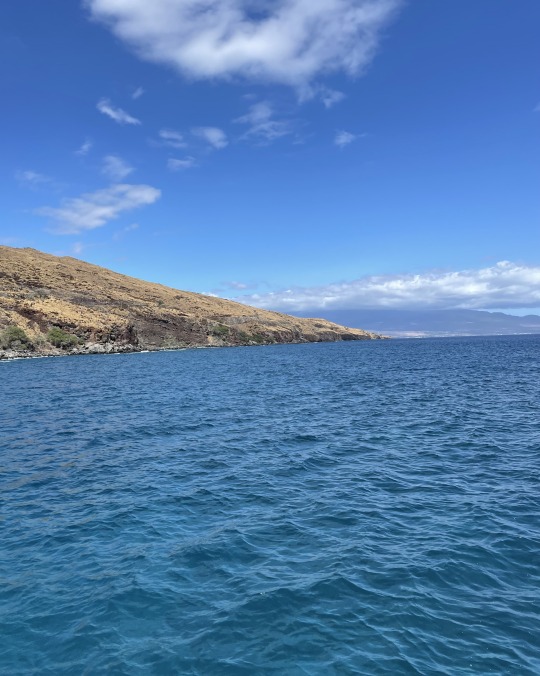
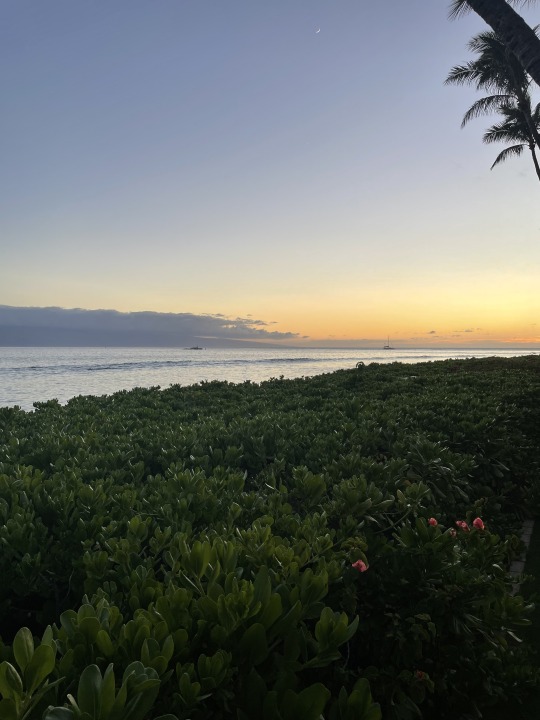
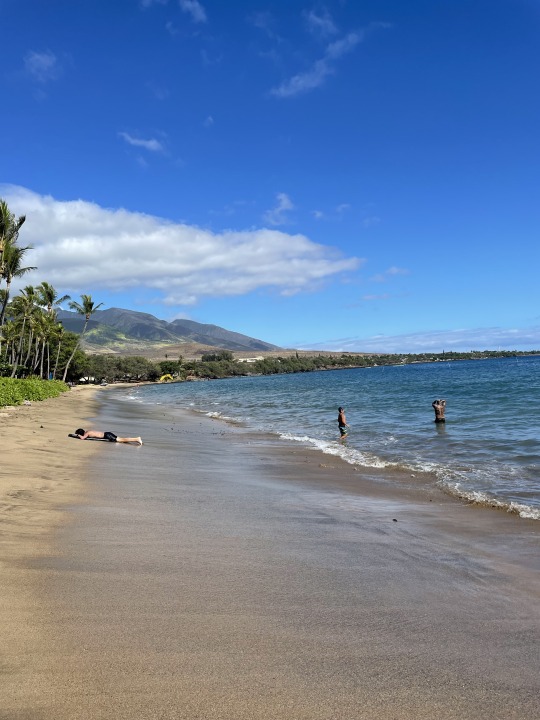
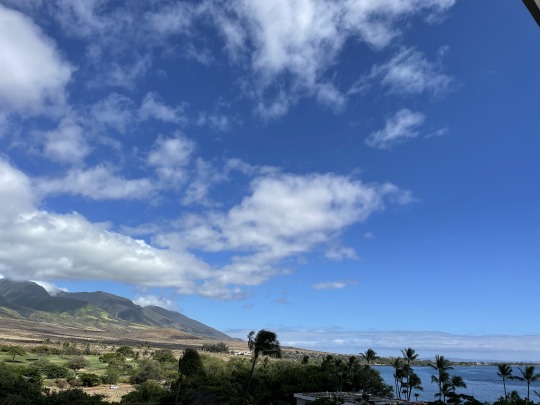
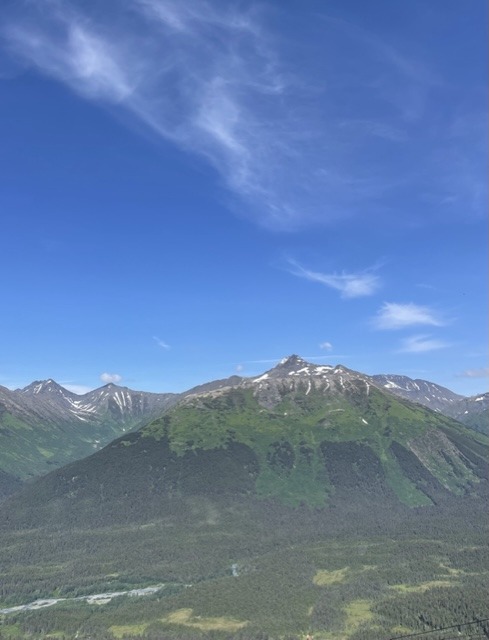
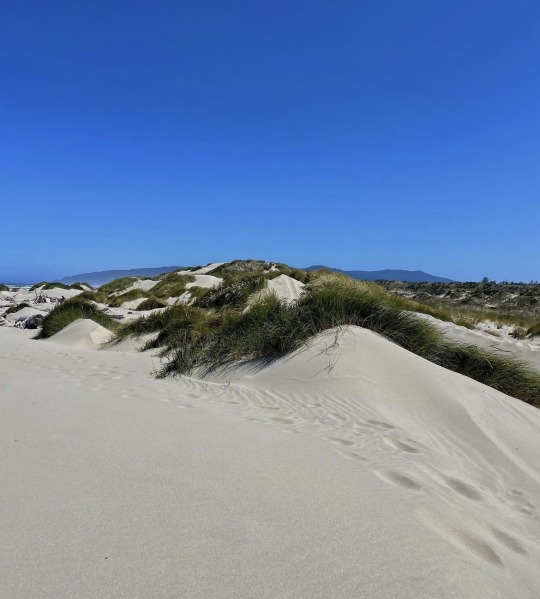
I have also included a photo of myself and one of the campers singing You Belong With Me, along with a video of everyone jamming out to Love Story at karaoke night.
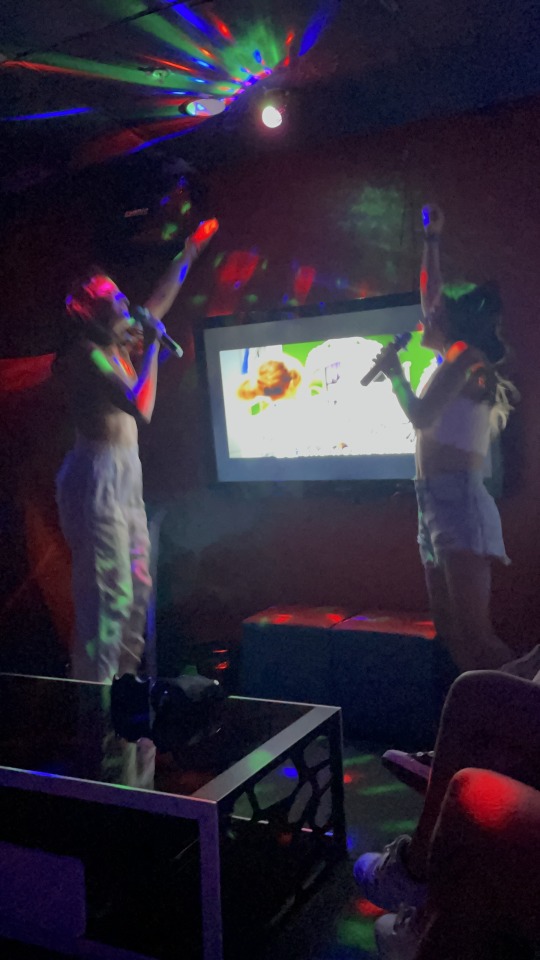
0 notes
Text
The pipeline from moon song to Noah Kahan
Where is music in nature? Where is nature in music?
When I think of “music in nature”, I think of the sounds produced by the plants, animals, and wind. The rustling of leaves, birds calling, the rush of a river, buzz of cicadas in the summer sun. When I was little, I associated the sound of the cicadas with the sun coming out from behind the clouds, and I thought the buzz was the sound the sun made. I didn’t know what cicadas were and just figured the sun buzzed except for when it was covered by clouds. When I was even younger, I would look at the moon out the car window and notice how it “followed” us. Eventually I started shouting at my parents about how the moon was still out the window, in very limited vocabulary. This turned into us making a little song or more of a chant, just consisting of the word moon. We would sing this every time we could see the moon “following” us when we were driving. I think it is interesting how we make associations like this, even if I was totally wrong with both of them. These are the first memories I have of trying to make sense of the world around me, and almost immediately, my parents formed a little song with me to go along with it. This is why I think “music in nature” and “nature in music” are like 2 sides of the same coin. It was the natural phenomenon which inspired our song about the moon, so you could say this relationship began as nature in music. However, once the moon song became a habit to sing in the car, this relationship morphed into music in nature, because we used it to connect with the night sky.
Therefore, music in nature can be whatever songs we take with us as we enjoy the outdoors, whether they be from the mainstream radio, or ones we’ve made up on our own. I think this relates with the popularity of chants and songs at summer camp, especially camps that take place outdoors. They are an easy, catchy way for everyone to connect with each other, and with whatever aspect of the outdoors the song is about.
On the other side of the coin yet still the same concept, nature in music has been instilled in us since pre-school. I remember a song that I am sure many of you also know, that went something like “I caught a little baby bumble bee, won’t my mommy be so proud of me”. I remember such songs being a main component of learning about animals and the outdoors. I think these were so influential for us because we would be able to sing them on our own whenever we found ourselves outside and continue our learning.
Another aspect of this topic that I think is relevant is the use of white noise machines that play nature sounds such as the surf crashing against the sand, rain pouring, or birds chirping. Many people find these noises relaxing and even use them to help them sleep (Gould van Praag et al., 2017). Nature sounds have been found to help alleviate anxiety and depression, and promote mental rest, among other benefits to our psyche (Gould van Praag et al., 2017). I’m sure we can all vouch for the healing powers of a good sit by a river, so it is good to know that there is scientific research and findings to back these experiences up!
Something else I wanted to touch on in terms of nature in music, is the influence of social media platforms such as tiktok and Instagram. Perhaps it is niche to the side of tiktok I am on, but I have noticed that certain types of music are heavily linked to nature content. Certain sounds will only be used for nature content exclusively, often folky music and artists (Noah Kahan comes to mind). These sounds and songs are usually used for the next nature compilation photo/video trend, where people will post their best moments from recent travels or hikes. I am a big fan of the trend!
Gould van Praag, C., Garfinkel, S., Sparasci, O. et al. Mind-wandering and alterations to default mode network connectivity when listening to naturalistic versus artificial sounds. Sci Rep 7, 45273 (2017). https://doi.org/10.1038/srep45273
0 notes
Text
Hello!
Your post makes a lot of sense, I particularly like the part when you say "The trails we walk and the rivers we cross have witnessed countless narratives." It is obvious but still feels like a profound realization, because we might not stop to consider this. Billions of people have lived and come to know many things, but nature has quite literally bore witness to it all. You've made me wonder, what would nature have to add, if it could share its "fly on the wall" observations.
Perhaps nature has seen the most honest side of humanity, because who are we when nobody is watching? I also like your very last line "Embrace the echoes of time, for in them lies the true beauty and integrity of our environmental narrative." It reminds me that human history and natural history (as we know it) cannot exist without the other.
I think this contributes to our obligation to integrity, as the quote argues. To offer fabrications of the past with little effort towards accuracy would be to do nature and people a disservice. I agree with your point about how certain groups of people have been muted, and I would add that this is also true for nature. Human hustle and bustle has drowned out the voice of nature, and I think this is why nature interpretation and historical interpretation go hand in hand. They are both about providing a voice.
Thanks for the thought-provoking post!
Blog 6: Embracing the Echoes of Time in Nature's Narrative
As we dive into the intriguing world of nature interpretation, there's this profound quote by Edward Hyams that caught my attention. Let's unravel it together and see how it intertwines with our journey through the historical lens of environmental science.
Hyams states, "There is no peculiar merit in ancient things, but there is merit in integrity." Wow, right? It's like a call to embrace the richness of the past not for its age, but for the integrity it brings to the present. Imagine nature as a story, and each chapter unfolds over time. To maintain the integrity of this story, we need to acknowledge and understand the parts scattered throughout history.
In writing, we enjoy the luxury of control. We can edit, refine, and sculpt our words until they mirror our thoughts perfectly. Just like how we carefully construct our sentences, nature interpretation demands the same consideration. Whether it's a blog, a sign in a park, or even a song about the environment, we are essentially narrators of a story that spans epochs.
Consider this – the next time you encounter a piece of environmental writing, let it be a conversation. Ask yourself, why does it work for you, or conversely, why does it fall flat? It's not just about the words; it's about how they resonate with you and potentially with others. Your words, at that moment, become the voice of nature, echoing through time.
Now, let's tie this into the historical aspect of our course. Whose history are we telling, and why? Privilege plays a significant role here. Acknowledging whose stories have been elevated and whose have been muted is crucial. Our responsibility as storytellers of nature is to bring forward authentic voices and experiences. The trails we walk and the rivers we cross have witnessed countless narratives. It's not just 'our' story; it's a collective tale, echoing through the ages.
Hyams goes on to say, "To think, feel or act as though the past is done with, is equivalent to believing that a railway station through which our train has just passed, only existed for as long as our train was in it." This hits home. Nature is not a static painting; it's a dynamic, ever-evolving masterpiece. Dismissing the past is like saying the train station only existed for the fleeting moment we passed through.
So, let's not just glance at history; let's dive into it. Let's be mindful narrators, weaving the past seamlessly into our environmental discourse. Our story is but one thread in the intricate tapestry of nature. Embrace the echoes of time, for in them lies the true beauty and integrity of our environmental narrative.
Happy exploring friends! 🌿✨
1 note
·
View note
Text
Processing the train, and keeping everyone on board
There is no peculiar merit in ancient things, but there is merit in integrity, and integrity entails the keeping together of the parts of any whole, and if these parts are scattered throughout time, then the maintenance of integrity entails a knowledge, a memory, of ancient things. …. To think, feel or act as though the past is done with, is equivalent to believing that a railway station through which our train has just passed, only existed for as long as our train was in it.
(Edward Hyams, Chapter 7, The Gifts of Interpretation)
Unpack this quote.
Our readings in the textbook this week heavily emphasized the importance of getting something on the page, little by little as ideas flow, and the process of continually editing the piece. In the spirit of this lesson, I thought I would post each step of edits as I form my blog post for this week (the large edits at least).
First draft: First impressions and thoughts
I see this quote as 2 separate ideas:
There is no peculiar merit in ancient things, but there is merit in integrity, and integrity entails the keeping together of the parts of any whole, and if these parts are scattered throughout time, then the maintenance of integrity entails a knowledge, a memory, of ancient things. ….
Peculiar meaning distinct (not strange)
Merit meaning worthwhile
Integrity meaning honesty and wholeness
People are required to couple integrity with history
The past without people = lack of connection to today
The past + people = a lesson for today
To think, feel or act as though the past is done with, is equivalent to believing that a railway station through which our train has just passed, only existed for as long as our train was in it.
The effects of an event continue to radiate even after the event has finished
Someone somewhere is affected, someone somewhere remembers
Who is on the train and where is the train going?
Does everyone on the train have the same point of view?
General messages:
History is less meaningful without interpretation and the addition of human voices and experience.
There is always something to be learned from the past and taken with us into the future
Second draft: Forming some points to branch off of and connect
1st part of the quote
Knowledge about the past is less informative on its own
History needs context provided by humans
Connect to textbook reading-actors, real people who lived through event
Information presented in multiple media forms is better received and might be more likely to encompass the full picture
Stories, people, artifacts, natural history, photos
2nd part of the quote
Gives us a better informed future
Train analogy is an example of interpretation (helps us understand better)
Connects to textbook readings- accessibility
Accessibility means making sure information is available and digestible for all, but also that the voices of all historical parties are included in the story
What might the train represent?
Incomplete historical representations lack integrity
Third draft: Piece together my interpretation and relate quote to course content
The first part of the quote argues that when on their own, historical artifacts or knowledge are not as useful or enlightening as they could be. Do people learn better from reading a passage or textbook, or by seeing historical artifacts along with a passage? Would it help even more to have someone with great knowledge on the topic available to present and walk through the information? Better yet, having someone there who’s lived through the event, to transfer this information even more seamlessly and genuinely. As we read in our textbook this week, people benefit when multiple mediums are used, because different learning styles and abilities need to be considered. The information is most accessible when it is presented in a variety of forms. Our readings mentioned the use of war veterans, and how we must take advantage of their one-of-a-kind knowledge. No amount of studying on a topic can replace actual lived experience and the anecdotes someone who’s lived the event would be able to provide. This is because people notice ingenuity and it is important to accurately represent the piece of history so as to not spread misinformation, as also learned from our textbook reading. I think this lesson from the textbook relates to the quote because the quote talks about how integrity relates to keeping all of history’s many parts together and accurate. Therefore, when interpreters use all possible resources in order to provide the public with the best representation of what actually happened (as recommended by the textbook), they are acting with integrity. This loops back to the involvement of real humans, (either those who’ve lived the experience like veterans, or those who are committed interpreters), because this (the involvement of real humans) is how we make sure that we are offering an unbiased and fair presentation (as recommended by the textbook).
This leads us to the second part of the quote. It argues that it would be naïve of us to believe that the past is truly in the past, just because it is over. This relates the first part (our goal of representing all sides of the story accurately), because certain voices no longer exist, yet we still aim to remember them and what they had to say. If we allow memories to die with the people that held them, then we are missing pieces of history and can no longer say that our understanding of the past is of high integrity. With the loss of pieces of the historical puzzle, comes the risk that we might not learn from the past. I think one of the main purposes of historical interpretation is to decipher what lessons are relevant to us today, and we miss more potential warnings with each memory that is lost. The train station analogy is helpful to interpret the rest of the quote because it provides a visualization of the text. This visualization helps me to picture relationships between historical interpretation, and the present. For example, the train might represent the journey through historical information. Who is on the train? Is the train available to everybody? If not, does this mean certain people cannot access information that they might need or want? Or, the train might represent society as we move through time. Does everyone look out the train window and see the same view? Is there room for everybody on the train? Who gets to talk on the train? Many groups of people today are affected by past events, even if they took place multiple decades ago. This is why the survival of stories from the distant past is crucial, and people need the opportunity to share them.
Ensuring that we are informed about all aspects of the past allows us to be better prepared for the future. Interpretation is one crucial way to inform the public and transfer relevant lessons and knowledge.
Did you interpret the quote in a similar way, or do you have different thoughts?
1 note
·
View note
Text
Hi Abby!
It sounds like you got many things out of the experience, some that you did not expect. I respect people who do this job so deeply! Using your summer to live somewhere remote and do an extremely tasking job in harsh weather conditions clearly shows how much you respect and care for the environment.
I think having completed this experience gives you a unique perspective on nature interpretation, because you saw nature through the days, months and weeks, rain or shine. Most of us only venture out in optimal conditions and thus only see nature on its good days. Maybe many of us only get to go out every week or a few times a month, so we notice the big changes, but miss everything that has happened in between. You would have had the chance to notice all the gradual, less obvious processes taking place day to day. To me, that is super valuable knowledge that can be shared with others who haven’t been in a position like yours before.
I also like how you talked about mental resilience and the changes you saw in your mental wellbeing over the course of your summer. Sometimes nature is there for us in ways we never expected, and in today’s society I think your message is more important than ever. Nature interpretation doesn’t have to offer a scientific perspective or an intense hike, maybe it could offer a simple mental reset. I think there is lots of opportunity to create programs more on the mental wellness side with knowledge like yours 😊
After having time to reflect on your last summer, will you do tree planting again next summer, or a summer in the future? If so, what mindset/knowledge will you take with you now that you are experienced already?
A reflection on my time as a tree planter
Blog Post 5:
This summer, I worked a s a tree planter in northern New Brunswick. My decision to immerse myself in this experience was driven by a desire to reconnect with nature, disconnect from the digital realm, and to discover the extent of my physical and mental resilience. This experience has transformed my perspective on nature and its profound impact on mental well-being more than I thought it ever could.
Spending so much time in the wilderness, removed from the noise of social media, hustle culture, and the rush of society, I was able to focus more on my own thoughts without being interrupted by the opinions of other’s. Spending so much time alone with my thoughts forced me to confront and observe the ways in which my thought patterns may be detrimental or beneficial to my overall well-being. The absence of notifications, the pressure of deadlines, and the stressors from everyday life allowed my mind to wander, explore, and feel a great sense of gratitude for many aspects of my daily life I had previously overlooked.


Near the end of my contract, I had a realization that I could actually tolerate more physical discomfort and pain than I thought, and I was able to plant more trees per day in the last two weeks than any of the days before. I knew going into the summer that tree planting would be both a physical and mental challenge, but what I did not expect is for the mental aspect to be the most difficult part. Over the course of the tree planting season, I saw many planters quit and go home. Even though everyone had some kind of physical injury throughout the season, I think the reason that ultimately led to people quitting was because of the mental challenges of this job.
Beyond the physical and mental trials, my time tree planting granted me a profound connection to the natural world. I had the chance to observe many different animals each day such as moose, dear, bears, snakes, frogs, and voles. I enjoyed watching the changes in the environment as all of the flora and fauna transitioned from spring to summer.



This experience also highlighted the power nature has to bring people together. Overcoming challenges together has a unique and powerful way of creating meaningful connections with others and I made many friends who I will have for years to come.
My summer spent tree planting was a transformative chapter in my relationship with nature and my understanding of its profound impact on mental health. I was reminded of the importance of spending time in nature, disconnecting from the digital world, and embracing discomfort as a path to growth.
2 notes
·
View notes
Text
My Passion Project Part 2
.....Continued....
I remember the first hatch I ever saw at my co-op, which was also the first hatch my coworkers had ever seen. We’d been gathered around all morning because we knew it was going to hatch that day (the chrysalis goes from green to translucent once it is time). When it came out looking all shriveled, we all freaked out and a couple of us actually cried because we thought we had messed up the process for the poor thing. We were all hysterical wondering how it was going to fly with such crumpled wings. Luckily, some minutes later, the butterfly had developed into its more well-known state after pumping its wings.
I will never forget that experience and the fear that quickly turned to wonder.
After I’d moved on from the farm, all the eggs I find come from my own backyard. I average about 60 per summer, so over the years I have released just around 300 monarch butterflies. I have only lost 4 caterpillars total over all the years, so I feel accomplished. The losses are due to disease, I can’t be for certain which one (monarch caterpillars are victim to many), but I believe mine have been affected by O.E. (Ophryocystis elektroscirrha). This is a protozoan parasite that waits on the milkweed host plant to be ingested by the caterpillars. It is known as the “black death” because affected caterpillars often blacken and deflate just before dying. Below I have included a photo of a dead, diseased caterpillar, the only one I lost this past summer. Diseases like O.E. are a reason why it is so important to clean milkweed leaves before feeding the caterpillars, using a 10% bleach water solution. This is also why it is important not to overcrowd containers, so that sick caterpillars don't have the chance to spread the disease. Caterpillars may also be implanted with eggs by tachinid flies, so I make sure to always keep the enclosure door closed, stay vigilant when I am cleaning out containers, and take containers indoors to clean if they will be staying open for a while.
This past summer, I raised exactly 70, 38 males and 32 females. It is not too difficult to determine the sex, the easiest way being taking a look at the wings. Males have thinner veins and 2 glands which you can see circled in the photo I attached. Females have thicker veins and do not have the glands, as seen in another photo I attached.
I have also included a photo of me at Guelph Bug Day, which has a decent view of my enclosure and caterpillar containers.
If you wish to follow along/see more about my monarch adventures, feel free to follow my Instagram account which is dedicated to my monarchs @madelinesmonarchs 😊
In the off season, I post about other insects now and then!
Hope you enjoyed!
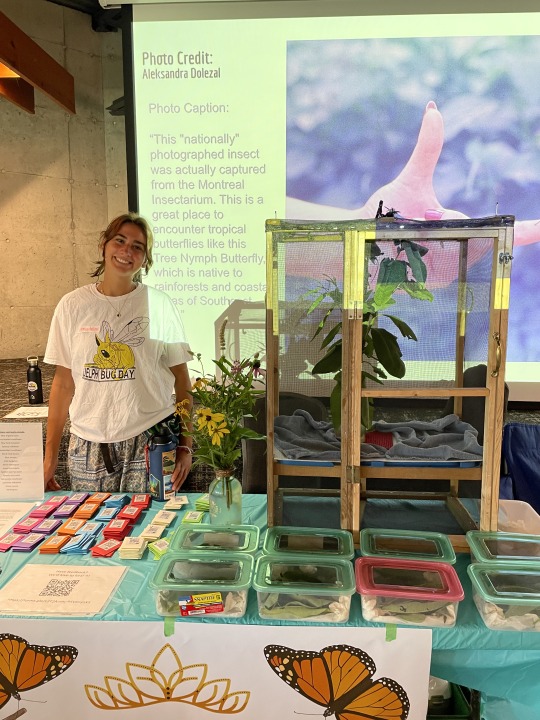
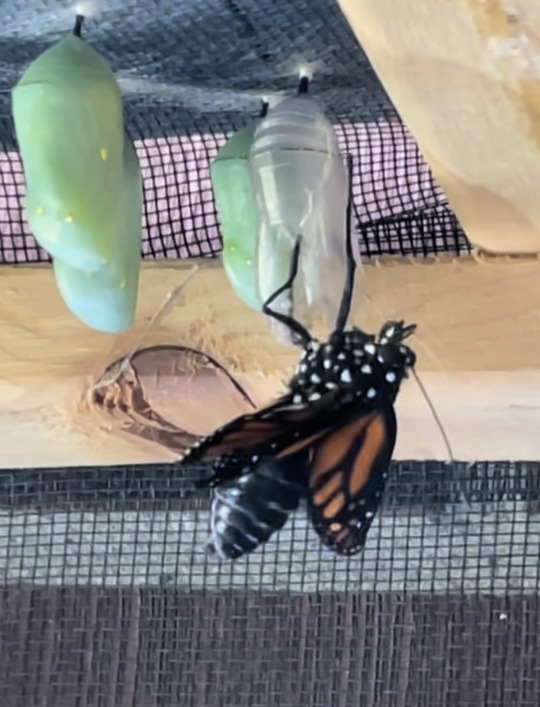






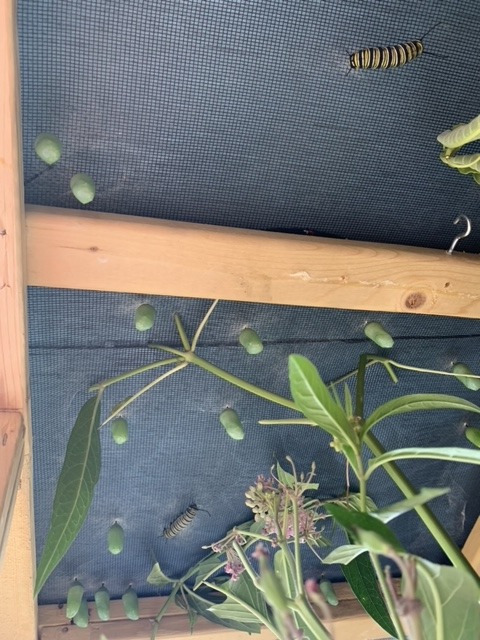
2 notes
·
View notes
Text
My Passion Project
No prompt this week – free write on what you are thinking about!
For this week, I want to share some more about my passion project which I also briefly mentioned some weeks ago. This will be in 2 parts because I have so much I want to share!
I raise monarch butterflies! I got into this about 5 summers ago, when my high school co-op had me take a training course on how to safely support monarch populations in raising them. After the training, we were cleared to start raising them on the farm where my co-op was taking place. Next to the farm was a massive milkweed meadow, where we would find countless monarch eggs and caterpillars to take back to the barn. At a certain point in that July, we were overrun by monarchs and were running out of space in the barn. We still wanted to be able to take them all in, so us 4 co-op students started taking the excess monarchs home and building support structures to keep them there. You might be thinking, well if you were finding so many, why the need to help them along? Doesn’t the high abundance of eggs mean the population must be alright? Well unfortunately not. In the training I received, they told us only a few out of a hundred eggs would be lucky enough to make it to the butterfly stage. After that summer’s experience, I was sold!
I worked on the farm another 2 summers after that one, and raising the monarchs just became my summer routine. I built an enclosure out of some spare wood and window screen and planted a bunch of milkweed in my backyard (common, swamp, and butterfly, though the butterfly didn’t take as well). I also planted some native flowering species for the monarchs and other pollinators, such as black-eyed susans, joe pye weed, echinacea, and hyssop.
I separate the caterpillars by instar, so that caterpillars of the same size and appetite share a container. I avoid overcrowding and usually won’t have more than 4 in one container for the first couple instars, and no more than 2 per container for their last couple instars. Once they get to their last instar, I move them out of the container, and into the enclosure. The enclosure is equipped with a few hefty stalks of milkweed for the final meals. When the caterpillars have had their fill, they will climb to the ceiling and choose a comfy spot to form their chrysalis. They attach themselves with a silk material, and assume a J position, which lasts for 2-3 days. Once they’re ready, they begin to straighten out and start a pumping motion. Within a few minutes, the caterpillar has disappeared and only the chrysalis is seen! If you have ever seen this happen, you know how amazing and quick it is! I wait for hours and hours to catch a good video, go inside to grab a quick drink and bam! It has happened by the time I come back. Luckily, I have caught the process many times so I can tell you how the pumping motion begins to peel off their skin to reveal the chrysalis underneath. Essentially, the caterpillar forms the chrysalis inside their body while they hang in the J position, so that when the time comes to turn, all they do is push their skin up and off. Enchanting! They’ll spend about 10-14 days in the chrysalis, but I have noticed that they will emerge faster if there’s been a heat wave (just an observation, I obviously don’t do any sort of manipulation). When they emerge, they look a bit deformed with a chubby body and crumpled wings. This is because all the fluid they are about to pump their wings with is being stored in their body. They’ll spend around 8 minutes pumping their wings, and the next thing they do is put together their proboscis. This structure acts as a tongue, and it is in 2 pieces when they emerge from the chrysalis.
If you wish to follow along/see more about my monarch adventures, feel free to follow my Instagram account which is dedicated to my monarchs @madelinesmonarchs 😊
In the off season, I post about other insects now and then!
Take a look below at some of the photos and videos I have taken over the years!
To be continued!
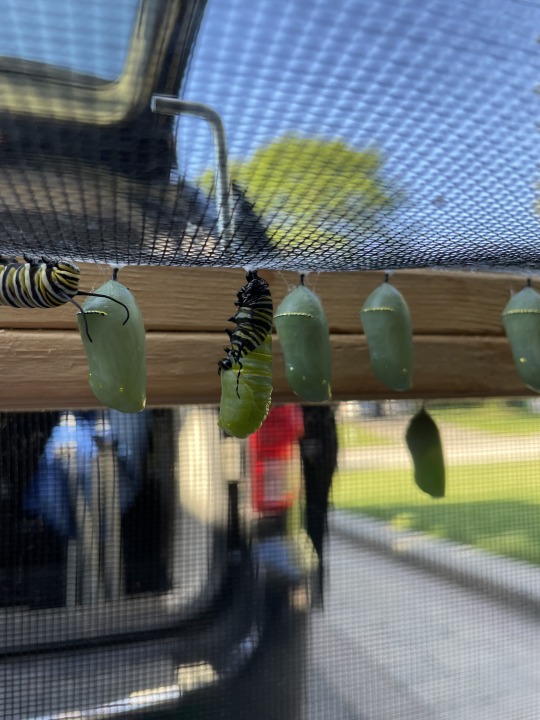




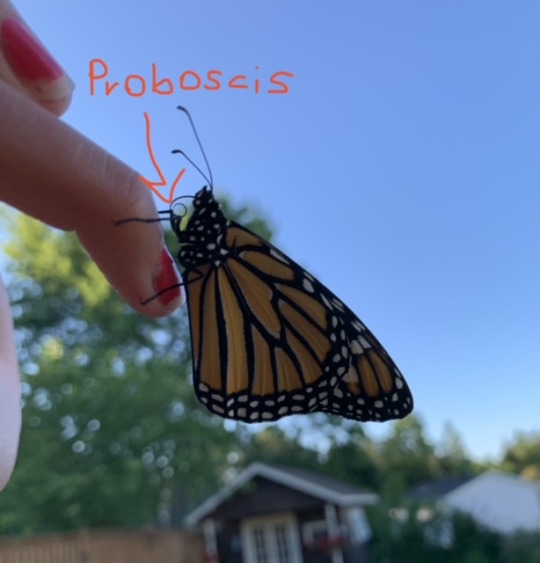
1 note
·
View note
Text
Hello!
I find your post insightful and I notice we made similar points about technology and how we are able to search online for any view that exists on the planet. We can reflect on places we've never actually been to, and I'm glad we both find that important to note!
Similar to how you are inclined towards song lyrics, I have always felt called towards poetry (and I feel like lyrics and poetry are pretty much the same thing). I had the Shel Silverstein collection consisting of his works "Falling Up", "A Light in the Attic", and "Where the Sidewalk Ends". The poems about plants and animals always caught my eye most, and I can still remember doing a poetry presentation in 3rd grade with his poem about a boa constrictor. All this to say, I think it is worth noticing how we retain art forms in this way, they stay with us throughout our lives. Through art and nature interpretation, we have the ability to be that experience, that "aha moment" that sticks with someone for the rest of their lives.
There is a popular poem written by Sylvia Plath where she describes the feeling of wanting many different kinds of lives through the imagery of a fig tree. After reading this poem for the first time, it has stuck with me because I definitely relate to the sentiment of feeling capable of so many things but not being sure which to pursue. I think this poem is a perfect example of combining art and nature interpretation. One is able to reflect on their own future through the fruitfulness of a fig tree which represents the giving, providing, and bountiful aspect of nature.
I wonder if you have a particular song or verse that has stuck with you in a similar way?

Blog 4
prompt: Who are you to interpret nature through art? How do you interpret “the gift of beauty”? (Your readings – specifically Chapter 5 of the textbook – will be helpful for this!)
Nature is something that is often difficult to describe in words. It brings to us a complexity that sparks emotions and feelings. There have been countless times where I, and I am sure others, have felt this way. Whether its an awe inspiring sunset or an animal in its natural habitat. Even something simple that has a great meaning to you, like a special creek or fishing hole. Art allows for a snapshot of these events that are often better at portraying how they made you feel, than words.
Art to me can be anything, from pictures, sculptures, paintings, and music. I have always consumed art, whether it be consciously or unconsciously. From my friends posting photos of nature online, to seeing paintings in my local museum and family members houses. I always understood, on the surface, what the purpose of these works of art were, however, never that in depth. This is something I have been actively trying to work on. If a work of art catches my eye, I will not only appreciate the vain beauty of it, but try to go deeper. Why was this created? What do the elements of the piece mean? Is there anything excluded from the piece, why? When you are critical in viewing art, you begin to see a story. You feel as though you are in the shoes of the creator of that piece. It is truly an amazing experience to be able to appreciate the moment that inspired the artist so much to want to capture it. This is a skill I am still working on, and will be forever as there are endless ways to look at and interpret art. That is what makes it so great, anyone, at any age can appreciate it in their own way and interpret the gift of beauty.
I have found that the one method of art that always intrigued me the most was music. Ever since I was younger, I have been in touch with the lyrics of songs and appreciated the story telling more than anything. This is why it is my favourite form of art. In just a three minute clip, someone can tell you a story about an event in their life. The instrumentals add to it as well. They can inspire emotions based on what the person is singing about and add a layer to that story that makes you feel as they did. With high upbeat tones making you feel happy or excited, as they were. To slow and drawn out instrumentals bringing sadness, longing, or defeat. There is an element of music that touches so many senses at once to provide a completely immersive experience of art.
Art can often seem as something that is exclusive. That is is something for the rich or more experienced to own and appreciate. However, what makes art so great is anyone can interpret it. This is why is it so important in regards to nature. Not everyone can see in person the great phenomena and beauty of it. However, especially with technology, it makes it easier than ever to view any piece of art. This allows a unique opportunity for anyone to experience a snapshot of events in nature that they likely never would have. it Allows anyone to build an appreciation for the gift of beauty that is nature.
4 notes
·
View notes
Text
Who are we, (individually and as a collective) in nature?
Who are you to interpret nature through art? How do you interpret “the gift of beauty”?
To me, one of the most inviting parts about nature interpretation, is that all you really need to get started is a passion for the outdoors. The landscapes aren’t exclusive about who can observe them. Of course, there is nuance with this as we discussed last week regarding privilege. Accessibility is an issue. On a very basic level however, the riverbeds and tree trunks aren’t watching us with judgment as if to say, “who is this measly human teaching this group of other measly humans about me?”, (or maybe they are and maybe we ought to be on our best respectful behavior). I like to think that nature is watching us with appreciation as we try to deepen the bond between humans and nature. If we wish to get started, we could begin with one singular tree in the break of the sidewalk. We could explore google earth, choose locations we feel particularly called to, and reflect on what it might feel like to be there. We could then draw or paint a picture of how the scene makes us feel. Our minds are the limit.
Some of our relationships with nature have only ever involved academia, and therefore exploring through art requires some courage and open-mindedness. Some of our relationships with nature were born through the artistic lens, and therefore might be a very comfortable process. As people interpreting nature through art, we might have some things in common. Perhaps many of us lean towards the creative side, perhaps we see humans and nature as being on the same hierarchy level, perhaps our parents washed a lot of mud out of our clothes when we were kids. Some of us might be painters, photographers, sketch artists, poets, and we are all bloggers! There is not a wrong way to interpret nature through art, and there are probably infinite options. Some people will be looking for hard facts and information. Is that everyone’s favourite presentation style? No, but it is somebody’s. Others may prefer an abstract approach that involves the senses instead of historic or ecological facts. So, who are we to interpret nature through art? Well, I believe we are just students of nature with no graduation date, intrinsically driven to know and share as much as we can about it, in a variety of mediums. We are all humans who find inspiration or comfort of some kind in nature, and express it differently.
As stated on page 82 of our textbook, army park guards were the original interpreters of many national parks. This career path for some or hobby for others is sometimes stumbled upon by chance or circumstance. Folks might end up in such a role even though it was not their original plan. In those cases, I think there must have been some compelling factor that drew them in or kept them from pursuing their original plan, perhaps “the gift of beauty”. In our textbook, the gift of beauty is described as the awareness and recognition of the inherent wonder of the environment. The idea is that this sentiment gives us peace with our place in nature and drives us to protect natural systems. The gift of beauty could be a starting point for many who either seek involvement in nature leadership, or as a participant.
As we read in the textbook, if we put words to a scenic view and try to describe its beauty, we often fail to do it justice. We would also be taking away from the imagination and creativity of the moment for the viewer. This is what makes “How do you interpret the gift of beauty” a difficult question. The answer is different for everyone. We might all be able to agree that a bright sunny day in a wildflower field has a calming effect. However, we might not all be able to agree why it has this effect on us. For some, maybe it reminds them of summers at their grandparent’s house. For someone else, maybe it is the presence of pollinators and getting to observe their interactions with the flowers. In my mind, the gift of beauty differs from a sense of place, in the way that you can give someone a sense of place, but perhaps the same cannot be said about the gift of beauty. I think holding space for the group to come up with their own conclusions and reflections is important. Younger groups might need some prompts or reflection questions, others might only need your guidance to the lookout point. I believe interpreting the gift of beauty is about giving someone the opportunity to see that the world is beautiful, and allowing them to decide why they think so.
At the end of the day, you want your group to form their own connection with the space, and personal feelings of relatedness. When this happens, the nature interpretation doesn’t end when they leave the green space. Now, they have this relationship that they contributed to individually within themselves, and they can always return to that feeling and headspace without even being outdoors.
1 note
·
View note
Text
Hi there, I enjoyed reading your post and think you make some interesting points.
I also think socio-economic status can influence people’s chances of getting involved in the world of nature interpretation. In the obvious sense in that maybe they can’t afford such trips as you mentioned. Then also perhaps if they ever had the means to buy fancy camping gear and go backpacking, they might feel as if they have already gotten too behind and can’t start now. Maybe they’ll feel like they are too old to begin, and don’t want to look silly to the younger crowd. The privilege of being able to get involved in outdoor experiences early in life could be a factor in whether people feel confident to get involved later. Feeling like you have a place in the world of nature interpretation is a privileged mindset in itself.
It is so true what you mentioned about where we live having influence on how we see the world. To me, Denali National Park was one of the most amazing things I’d ever seen, but our bus driver opted out of coming with us when given the chance because he had just done it so many times. If we are exposed to such sights and opportunities to be with nature, I guess it becomes mundane. There are many people craving just a day of what some people get to experience, so as we spend more time in nature, does our appreciation for it decrease? I think there are people whose appreciation rises steadily with the more time spent outdoors, because they recognize how extraordinary the planet is. Maybe it is up to us to decide if our appreciation will continue to grow, or plateau.
Unit 03: Risk versus Reward in Interpretation
What role does “privilege” play in nature interpretation? Please include your working definition of privilege.
The discussion of privilege can be a tricky one as it refers to sensitive matters such as level of education, income, socioeconomic status, and race. There has always been a sort of divide between people who have that privilege and who does not. This can affect the ways people perceive the world due to the way they feel they are treated in society. In the case of nature interpretation, this can have a great impact on how people of privilege see nature compared to the ones who are not. There is the idea that people who live in more urbanised areas will be less likely to experience nature, whereas people who reside closer to national parks will have a greater advantage in perceiving nature firsthand. There are alternate ways of interpreting nature without having to frequently visit the places, however, there is little doubt that it is the ‘privileged’ ones who will understand nature and the wild more.
There is also the matter of income. Some people may not be able to afford fancy holidays to the other side of the world where nature is very different to home. This could influence people’s interpretation of nature because it could mean that they have not experienced the potential excitement of travelling and experiencing the world in the same way as someone who is an avid traveller. Therefore, they would not feel the need to teach or learn about this subject. Similarly, this can be applied to the level of education someone has received. If they have not been taught certain aspects of the world, they are less likely to pay attention to such matters.
You could argue though, that for someone who is not used to experiencing and interpreting nature in their lives, this new experience that eventually occurs, can be very thrilling. Meanwhile, people who see it as the norm, they will interpret nature in quite a contrasting way. For example, as an exchange student from London, I could be a lot more excited to experience Toronto and the surrounding national parks, while a typical Canadian may not as it is the norm for them. This shows that a lack of privilege can have a significant impact on someone’s nature interpretation in a positive way.
2 notes
·
View notes